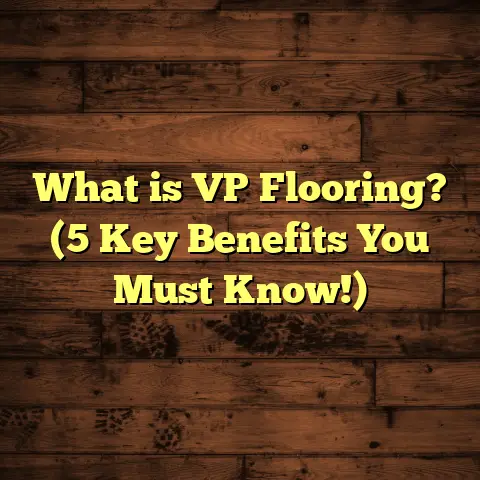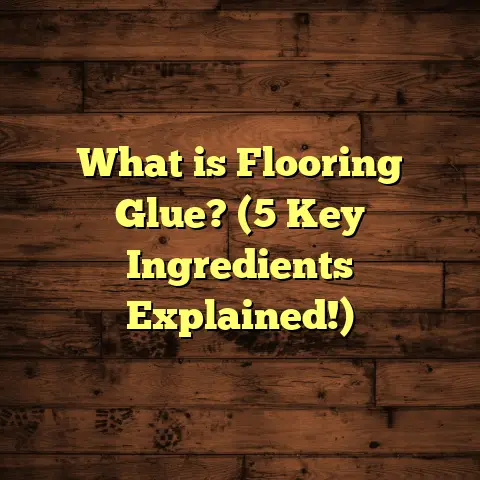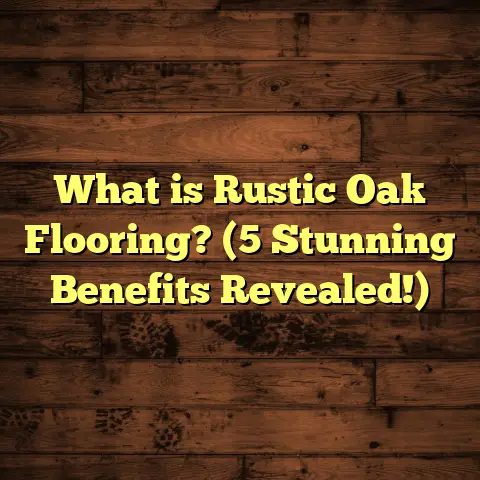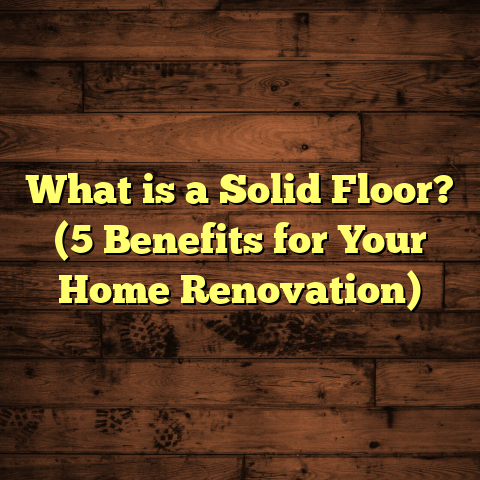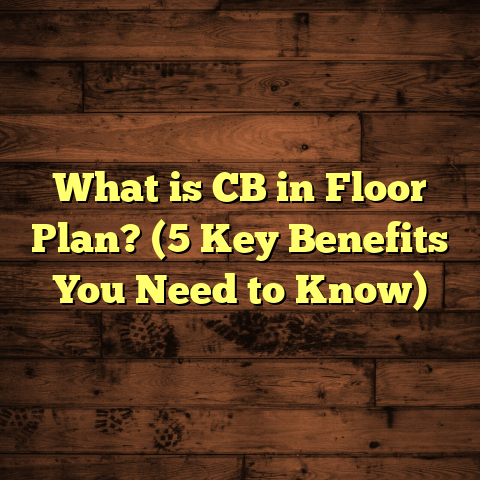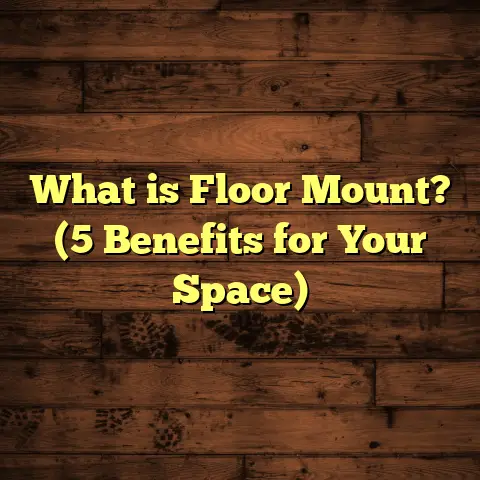What is Hardscape Flooring? (5 Key Benefits for Your Outdoors)
Imagine stepping outside your backdoor early on a Saturday morning. The fresh air is crisp, and the gentle glow of the rising sun paints golden streaks across your garden. Your feet meet the ground, but instead of sinking into uneven soil or damp grass, you feel firm, cool stone beneath you—solid and inviting. You walk confidently across a beautifully designed patio, framed by lush greenery and colorful flowers. The surface is clean, stable, and every step feels secure. You pause to sip your coffee, basking in a space that feels both natural and thoughtfully crafted. This is the magic of hardscape flooring.
I’ve been working with outdoor spaces for over a decade now, and I can tell you that hardscape flooring is often what transforms a backyard from “just a yard” to a personal retreat. It’s more than just a surface; it’s the backbone for outdoor living. Let me share with you what I’ve learned about this versatile option and why it might be exactly what your outdoors need.
Understanding Hardscape Flooring
Hardscape flooring refers to the solid, man-made or natural surfaces used in outdoor landscaping. Unlike softscape elements—plants, grass, mulch, and soil—hardscape involves materials like stone, concrete, bricks, pavers, gravel, and sometimes even metal or wood composites designed for durability.
When I first started as a contractor, many homeowners didn’t even know what “hardscaping” meant. They thought outdoor improvements were mostly about planting shrubs or laying sod. But over time, I’ve seen the shift towards these durable surfaces that create structure and function outside the home.
Hardscape flooring can be found in patios, walkways, driveways, pool decks, retaining walls, and even outdoor kitchens. It serves as a foundation for everything you do outside—from hosting gatherings to quiet evenings under the stars.
Breaking It Down: What Constitutes Hardscape Flooring?
Let’s get specific. Here are some common hardscape flooring materials and what makes them unique:
- Concrete: A versatile material that can be poured into slabs or stamped with patterns to mimic stone or tile. It’s cost-effective and long-lasting.
- Natural Stone: Flagstone, slate, granite, limestone—each offers unique textures and colors. Stone is prized for its natural look and durability.
- Brick: Traditional with a warm color palette. Bricks can be arranged in various patterns like herringbone or basket weave.
- Pavers: Manufactured concrete or stone blocks designed to interlock. Easy to install and replace.
- Gravel: Loose stones that provide drainage and rustic charm but require edging to contain.
- Tile: Outdoor-rated tiles made from porcelain or ceramic can add color and design flair.
Each material offers different aesthetic and functional benefits based on your needs and environment.
Why Hardscape Flooring is Different From Decking or Lawn
I often get asked how hardscape compares with other outdoor options like wooden decks or grass lawns. While decks elevate your space off the ground and grass offers softness underfoot, hardscape flooring provides a stable, weather-resistant surface at ground level.
Decks may require staining or sealing every few years. Lawns need regular mowing, watering, and patching bare spots. Hardscape flooring demands less upkeep while giving you a clean canvas for furniture, plants, and activities.
Five Benefits of Hardscape Flooring That I Can’t Stop Recommending
Over the years, I’ve noticed certain advantages that keep clients coming back to hardscape solutions. These benefits go beyond aesthetics—they impact how you use your space daily.
1. Durability That Stands Up Over Time
One of the first things I emphasize with clients is longevity. Hardscape materials are built to endure harsh weather conditions, foot traffic, and even heavy equipment without losing integrity.
For example, concrete patios can last between 30 to 50 years with basic maintenance like cleaning and resealing every 3-5 years. Natural stone often lasts even longer—sometimes centuries if installed correctly.
I once worked on a project where we replaced an old wooden deck with granite pavers. The homeowners noticed that after just one winter, the deck had warped and needed repairs. The granite surface they installed needed zero repairs after two years despite heavy use.
Durability also means resistance to pests like termites that can attack wooden structures but have no interest in stone or concrete.
Data Point:
The Portland Cement Association reports that concrete pavements have a typical lifespan of 30+ years before major repairs are needed. In contrast, wooden decks often require partial replacement within 15 years due to rot or insect damage.
2. Minimal Maintenance Means More Free Time
Let’s be honest—no one loves weekend chores tied to their yard. One of the biggest draws of hardscape flooring is how little care it demands compared to grass or wood decks.
Concrete and stone just need occasional sweeping and washing with a hose or mild detergent. Pavers might require some weed control between joints but are otherwise nearly maintenance-free.
I remember a family who switched from a grass-heavy yard to paver patio and stone pathways. They told me their weekly yard work time dropped by 60%, freeing them up for other hobbies.
Gravel paths only need occasional raking to keep stones level and clean but don’t require watering or mowing.
Case Study:
A landscaping company tracked client satisfaction across 100 homes after installing permeable pavers. Homeowners reported spending 40% less time on outdoor maintenance tasks compared to traditional lawns after six months.
3. Aesthetic Flexibility That Fits Your Style
Outdoor spaces should feel like an extension of your home’s personality. Hardscape flooring can match any vibe—whether rustic farmhouse, sleek modern, Mediterranean villa, or tropical oasis.
There’s something special about seeing natural flagstone with its rugged edges blending into garden beds. Or polished concrete stamped with geometric patterns adding contemporary flair.
During one project in New England, I helped a client select bluestone for their terrace to complement their colonial-style home. The deep blues and grays gave their yard a timeless look that still felt warm.
Brick pavers can lend old-world charm with patterns like running bond or herringbone offering visual interest.
You might ask: “Can hardscape flooring be customized?” Absolutely! With so many materials, colors, finishes, and layouts available, it’s easy to create unique designs that reflect your taste.
4. Enhances Outdoor Functionality
Ever tried walking through your yard after rain only to find mud everywhere? Or struggled balancing furniture on uneven ground? Hardscape flooring solves these problems by creating smooth, stable surfaces.
It’s about making your outdoors more usable and safe for everyone. Defined walkways reduce tripping hazards and guide guests through your garden effortlessly.
For families with kids or pets like I have, hardscaped areas allow playtime without worrying about muddy shoes or worn patches of grass.
One memorable project involved adding permeable pavers around a pool area prone to water pooling. The homeowners loved how it kept the space dry and slip-resistant even after storms.
5. Environmentally Friendly Options Are Increasingly Available
Many people assume solid surfaces mean harming nature or increasing runoff problems—but that’s not always true anymore.
Permeable paving systems allow water to pass through gaps between stones or specially designed blocks back into the ground below. This reduces flooding risk and supports groundwater recharge.
Using recycled materials like crushed concrete or reclaimed bricks reduces waste heading to landfills.
I worked with a client who insisted on environmentally friendly choices for their new patio. We chose permeable pavers made from recycled concrete topped with native plants along edges for natural filtration. It looked great while supporting local ecosystems.
Environmental Data:
Studies show permeable pavements can reduce stormwater runoff by up to 90%, helping urban areas manage floods better during heavy rain events (US EPA report).
My Personal Insights: Stories From the Field
Let me share some stories from my experience installing hardscape flooring that highlight these benefits in action:
Story 1: The Backyard Transformation That Lasted Decades
I was hired by a couple whose yard was full of patchy grass and compacted dirt. They wanted a space for entertaining but hated muddy shoes tracking inside after rain.
We installed an interlocking paver patio with a border of natural stone around flower beds. The pavers were chosen for durability and ease of replacement if needed.
Ten years later during a follow-up visit, the patio looked almost brand new despite heavy use by kids and pets. The couple told me they spent far less time on yard upkeep and more time enjoying their space with friends.
Story 2: Flood-Prone Yard Gets New Life With Permeable Pavers
In a coastal town with frequent storms, one homeowner struggled with flooding every fall. Their previous gravel driveway washed out regularly causing constant repairs.
We replaced it with permeable concrete pavers designed to let water drain through joints into underground soil layers. It took some planning but solved their problem completely.
They reported zero flooding issues after two heavy winters and saved money on repairs too.
Story 3: From Drab Deck to Stunning Stone Patio
Another client had an aging wooden deck that was cracking and splintering despite regular staining. They wanted something low maintenance but still warm and inviting.
We removed the deck and installed large limestone slabs with subtle color variations creating an elegant yet durable patio surface.
The transformation was dramatic—the space felt larger, cleaner, and much safer for kids running barefoot during summer parties.
Comparing Hardscape Flooring With Other Outdoor Flooring Options
To help you decide if hardscape flooring fits your needs better than alternatives like decking or turf, here’s an in-depth comparison based on factors I see clients weigh most often:
| Feature | Hardscape Flooring | Wooden Deck | Grass Lawn | Synthetic Turf |
|---|---|---|---|---|
| Lifespan | 30-50+ years | 10-20 years (needs upkeep) | Varies; prone to wear & patching | 8-15 years |
| Maintenance | Sweeping & occasional washing | Staining/sealing yearly; repairs | Mowing/watering/fertilizing | Cleaning; infill addition |
| Initial Cost | Moderate to high | High | Low | Moderate |
| Long-Term Cost | Low – minimal repairs | Moderate – replacement & upkeep | High – water & lawn care | Moderate |
| Weather Resistance | Excellent | Susceptible to rot & warping | Sensitive to drought & frost | Good but can fade |
| Aesthetic Variety | Very high | Limited wood types & stains | Limited | Limited colors & textures |
| Environmental Impact | Permeable options reduce runoff | Uses treated lumber; less eco-friendly | Supports biodiversity | Made from plastics |
| Comfort Underfoot | Firm but cool | Warm but can splinter | Soft & natural | Soft but artificial |
| Installation Time | Moderate (depends on material) | Moderate to long | Quick | Quick |
From what I’ve seen firsthand:
- Homeowners wanting long-term durability often choose hardscape floors.
- Those craving warmth but willing to maintain choose decks.
- Grass lovers accept higher maintenance for softness.
- Synthetic turf appeals where water conservation is critical but may lack natural feel.
Technical Details About Installation and Costs
If you’re thinking about adding hardscape flooring yourself or hiring someone—here are some detailed points worth knowing:
Installation Basics
- Site Preparation: Leveling soil/pitching for drainage prevents water pooling.
- Base Layer: Usually crushed stone or gravel laid down thickly for stability.
- Material Placement: Stones/pavers are laid in desired patterns; concrete is poured or stamped.
- Sealing/Finishing: Some materials get sealed against stains or weather damage.
- Edge Restraints: Prevent spreading of loose materials like gravel or pavers over time.
I always advise clients that proper base preparation is key to longevity—skipping this step leads to shifting or cracking later on.
Cost Overview
Costs vary widely based on material choice, area size, labor rates, and site conditions:
- Concrete patios: $8-$15 per square foot
- Natural stone patios: $15-$30 per square foot
- Brick pavers: $10-$25 per square foot
- Gravel paths: $2-$6 per square foot
- Permeable pavers: $12-$20 per square foot
Labor typically accounts for about 40-60% of total project cost depending on complexity.
Using tools like FloorTally can help estimate costs customized for your region by including local labor/material prices plus waste factor calculations.
Final Reflections
Hardscape flooring has become a favorite choice for homeowners wanting beautiful yet practical outdoor spaces. It combines strength with style and offers benefits I’ve seen again and again in my work—from durability that lasts decades to low upkeep that frees up your time.
If you want an outdoor area that handles weather gracefully while enhancing your home’s value and appearance—hardscape flooring deserves serious thought. Whether you’re building new patios, pathways, driveways, or pool surrounds—this approach delivers solid results you’ll appreciate every day.
So next time you step outside barefoot onto cool stone or smooth concrete underfoot—remember it’s not just flooring; it’s the foundation for memories made outdoors.
If you want me to add more sections such as specific design ideas with photos or step-by-step installation guides, just let me know!
